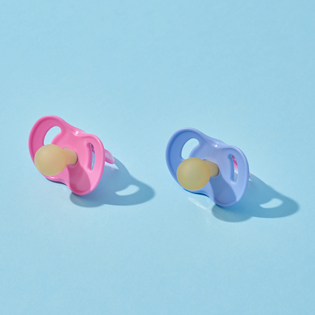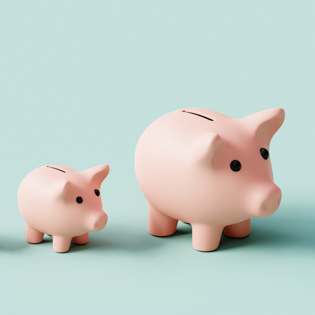Puréed butternut squash is a popular early food for brand-new eaters. But if you’re introducing solids in the form of baby-led weaning or your baby is ready to graduate from spoon-fed purées, you might be wondering when this orange veggie is safe to add to baby's menu — and how best to serve it.
When can babies have butternut squash?
If you're spoon-feeding your little one purées, you can introduce butternut squash anytime after your baby starts solids, usually around 6 months. And in fact, many parents who go the spoon-feeding route make this versatile veggie one of their child's very first foods!
Planning on introducing butternut squash as a finger food, baby-led weaning-style? Your new nosher can sink her teeth (or rather, gums) into the sweet veggie as soon as she’s capable of self-feeding — once she's at least 6 months.
How to prepare butternut squash for your baby
Steamed, baked or roasted butternut squash all work for babies and young toddlers. Just make sure the squash is cooked until very soft — if you can smush it easily between your fingers, your mini muncher will be able to break the veggie down with her gums or emerging teeth.
Make sure to remove the hard outer peel and any stringy or fibrous bits before cooking. Both can be tough for new eaters to manage and could be a choking hazard.
While many butternut squash recipes call for ingredients like brown sugar or honey, it’s best to steer clear of added sweeteners (even as part of veggie dishes) before your cutie’s second birthday. (And never serve honey to babies under 1.) Stick with flavoring your baby or toddler’s squash with herbs or spices instead, like a pinch of sage, cumin, cinnamon or nutmeg.
Read This Next
The tips below can help parents determine how to serve butternut squash at different stages, but keep in mind that all babies develop at their own pace. Speak with your pediatrician before beginning baby-led weaning, and talk to him or her if you have any concerns about your child's oral-motor skills, chewing skills, swallowing skills or if you're unsure whether or not your baby is ready for certain food preparations.
How to prepare butternut squash for a 6-month-old
Slice peeled and roasted, steamed, or baked butternut squash into thin, fry-like strips for your baby to palm and gum. Slicing the squash with a crinkle cutter before cooking makes for a fun shape — and can help your baby get a better grasp.
You can also offer puréed or mashed squash on a preloaded spoon for her to pick up and try serving herself.
How to prepare butternut squash for a 9-month-old
Dice peeled and roasted, steamed, or baked butternut squash into small pieces for your baby to practice picking up with her developing pincer grasp.
How to prepare butternut squash for 12 months and older
Give your new toddler a chance to develop her fork skills by spearing small cubes of roasted, steamed or baked squash (still peeled, of course!).
She can also use her fork or a spoon to practice digging into a baked or roasted squash half. Just keep an eye out for any stringy bits or rogue seeds.
Butternut squash recipes for babies and toddlers
One of the best things about butternut squash is how it sits right in between sweet and savory — which means there are lots of delicious ways to serve it. Just remember to always introduce one food at a time, especially top allergens like eggs, peanuts, soy, wheat, dairy and seafood.
A few tot-approved butternut squash ideas to try:
- Spiced butternut squash oven fries. Toss peeled, diced squash strips with olive oil and sprinkle with sweet paprika. Bake until soft and golden.
- Butternut squash pancakes or muffins. Fold shredded butternut squash into whole grain pancake or muffin batter.
- Butternut squash-bean cakes. Make mini veggie patties with mashed butternut squash and black beans. Pan-fry or bake until golden.
- Butternut squash quesadillas. Spread mashed butternut squash on a whole grain tortilla. Top with cheese, fold and pan-fry until golden. Slice into strips or wedges.
- Mashed butternut squash. Mash steamed butternut squash with unsalted butter and a pinch of cinnamon.
- Butternut squash-coconut soup. Sauté onions and garlic in olive or coconut oil. Add peeled, diced butternut squash cubes and coconut milk; simmer until squash is soft. Blend until smooth.
- Butternut squash noodles. Steam or boil spiralized butternut squash noodles until soft. Toss with browned butter and finely chopped sage. Cut the noodles into small pieces or let your tot grab the long strands.
What are the benefits of butternut squash for babies and toddlers?
Butternut squash is chock-full of vitamin A, which keeps your little one’s immune system in fighting form and promotes healthy vision. It’s also rich in vitamin C, which enhances absorption of iron — a mineral tots don’t always get enough of.
Other butternut benefits? The starchy veggie is a source of complex carbohydrates, which are a good source of fuel for your baby or toddler’s brain. The fiber will help stave off constipation, too.
Can babies be allergic to butternut squash?
Butternut squash allergies are not considered common. Even so, it’s always a good idea to look for signs of a possible reaction — especially when you’re serving it for the first time.
Your baby or toddler might have a food allergy if, soon after eating (within minutes to a few hours), she experiences:
- Hives
- Itching
- Skin, lip or tongue swelling
- Sneezing
- Wheezing
- Throat tightness or trouble swallowing
- Nausea, vomiting, stomach pain or diarrhea
- Trouble breathing
Call your doctor right away if your child experiences symptoms of an allergic reaction. An allergic reaction may be more severe or possibly life-threatening (called anaphylaxis) if multiple areas of the body are affected. In the rare event that your child shows signs of a life-threatening allergic reaction like trouble breathing or swallowing, call 911 right away.
Is butternut squash a choking hazard for babies?
Chunks of raw veggies are a top choking hazard for children. Make sure you're preparing butternut squash safely by always roasting, steaming or baking it until it's soft enough to smush between your fingers, and offer it in a safe size for your child's age (in long strips for the youngest eaters, then small, bite-sized pieces once your child has developed her pincer grasp).
Make sure, too, to always supervise your young child when she's eating, sit her upright during mealtimes and never offer food while she's reclining, walking, sitting in a car seat or playing.
When it comes to butternut squash, your new eater doesn’t have to stick to just purées (although you certainly can't go wrong by serving up some mashed or puréed butternut). The sweet orange veggie makes for a tasty early finger food, too. Just make sure to have extra on hand for when your baby or toddler gobbles it up — and signals for more.














































 Trending On What to Expect
Trending On What to Expect





